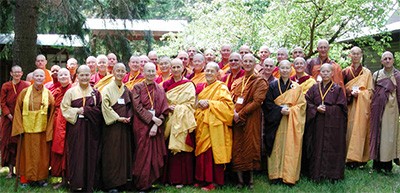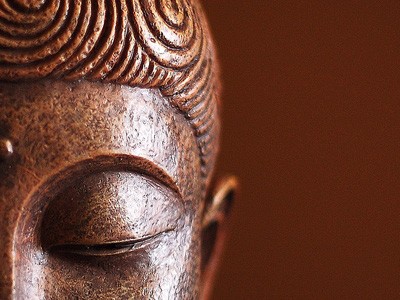Western monasticism

Report on the 14th annual gathering of Western Buddhist monastics, held at Shasta Abbey in Mount Shasta, California, June 23-27, 2008.
Being with the monastic sangha is a privilege, and being with monastics from many different Buddhist traditions is a joy. The color of each tradition’s robes was distinct, yet blended with the others—the ochre robes of the Thai Forest Tradition, the brown and gray robes of Chinese Ch’an and Vietnamese Zen, the brilliant orange robes of Sri Lankan Theravada, the maroon robes of the Tibetan Tradition, the brown and black robes of Soto Zen. There were 35 of us at this gathering; most of us were Western, some were Asian. We all lived in the USA and were engaged in practicing as well as teaching the Dharma here. Many of us were abbots or abbesses of Western monastic communities. Several had been ordained more than 30 years, several were ordained only recently, many were in the middle. The Shasta Abbey community joyfully hosted this event and took very good care of us all.
After morning meditation and chanting, we gathered each morning, afternoon, and evening for a session which generally consisted of a presentation followed by honest and sincere discussion and sharing. The presenters and their topics were:
- Ajahn Pasanno (Abhyagiri Monastery) spoke on the meaning of gradual training and the qualities needed by both teachers and students for successful monastic training.
- Bhikkhuni Sobhana (Bhavana Society), Rev. Seikai (Order of Buddhist Contemplatives), and Bhikshuni Tenzin Kacho (Thubten Dhargye Ling Center) addressed “Approach to the Four Requisites.” Is it possible to live as traditional monastics have, dependent on the generosity of others, in a culture in which such a life style is unfamiliar?
- Ajahn Amaro (Abhyagiri Monastery) and Khenmo Drolma (Vajra Dakini Nunnery) discussed monastic training. To what extent does the teacher guide the training and to what extent does the disciple guide it? How are disciples in each tradition guided in their practice—individually or in a group?
- Rev. Eko (Shasta Abbey), Ven. Heng Sure (Berkeley Buddhist Monastery), and I spoke on “Creating a Western Buddhist Monastery.” How do urban and rural training centers operate? What challenges and successes have we had in running them? Is it possible or even advisable to make a Western Vinaya?
- Ajahn Anandabodhi and Ajahn Chandasiri (Amaravati Monastery) and Ven. Heng Yin and Ven. Heng Je (City of 10,000 Buddhas) presented “Cultivating Seniority and Leadership Style,” which sparked a fascinating discussion about the diversity of ways to guide a community and lead disciples.
- Bhikkhu Bodhi spoke on “Challenges of Monasticism in the West.” How does diversity, the secularization of life, social engagement, and religious pluralism affect traditional monastic roles and life styles? As usual his insights stimulated our thoughts about the creative tension between adapting to the current times and remaining true to the tradition.
We also had a group discussion about our relation to the Asian Buddhist traditions from which we had sprung. The last evening we shared chanting as done in our monasteries as well as other Buddhist music. The Shasta Abbey choir chanted Buddhist hymns to Gregorian chant, Rev. Heng Sure taught us a variety of Buddhist folk songs which he played on guitar. Thich Nhat Han’s disciples taught us some of their chanting and songs, and those of us from Sravasti Abbey sang “Star Spangled Compassion.”
Having attended 12 of these 14 conferences, what is apparent to me is that we have become friends—not just acquaintances who nod their heads while thinking that their own tradition is the purest, but actual friends who understand and support each other as well as appreciate each others’ unique qualities. Looking back, I see how much these gatherings have informed the formation of Sravasti Abbey. That is, I’ve had the blessing of learning from others’ experiences of what works well and what doesn’t when founding a monastery in the USA. Due to these conferences, we’ve learned about the variety of Dharma practices; and we have visited, participated in, and in some cases taught in each others’ abbeys and monasteries. Most of all we have created a harmonious Mahasangha where monastics of many Buddhist traditions respect, appreciate, and support each other.
Venerable Thubten Chodron
Venerable Chodron emphasizes the practical application of Buddha’s teachings in our daily lives and is especially skilled at explaining them in ways easily understood and practiced by Westerners. She is well known for her warm, humorous, and lucid teachings. She was ordained as a Buddhist nun in 1977 by Kyabje Ling Rinpoche in Dharamsala, India, and in 1986 she received bhikshuni (full) ordination in Taiwan. Read her full bio.

